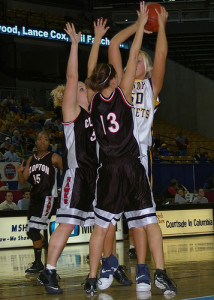7 Principles of Attacking a Press
When facing a Press there are a number of different principles that will help limit the impact of the traps effectiveness against a team. These principles are not strategies, but rather basic technical skills and tactics that will help develop consistency and effectiveness of a strategy against a press no matter the offensive philosophy or system being employed.
Have a Plan / Implement a Press Breaker Offense
There is more to beating a press or trap then just having a specially designed play against a particular formation. To be truly effective a press breaker offense would still need to feature a number of specific technical and tactics to be successful over an extended timeline against teams who have scouted it and are prepared for this strategy.
However, a starting point for every team should be to have a plan or press breaker offense for a team to implement. As a blueprint, a press breaker offense should be used, but this play should be flexible enough to deal with different variations or formations of the press or trap. By having this flexibility a press breaker offense will be more likely useful in the short and long-term.

Use Fakes to Shift and Trigger the Press
One key teaching point here will be to insist on players starting to implement basic fakes while advancing the ball down the court upon reception. The defensive players must be forced to try and cover a number of different possibilities while exposing others. One way of achieving this is to simply insist players utilise a pass fake to help move the defenders into passing lanes away from the intend options.
Another fake that can be useful is to ask players to jab step. Some zone presses or trapping defences react on the movement of the offensive player once the ball is inbounded. By using a jab step the ball handler can look as though they intend on moving that should see the defenders then commit to making the first movements within the press or trap.
Receivers must create a Lead Away from Catching Areas
A very common problem often overlooked by players especially when they are working within a press breaker offense is they fail to move the defenders away from the intend catching areas. Receivers need to first create a movement away from the intended catching area. This will shift the defender and hopefully facilitate a better catching opportunity with less pressure and contesting of the passing lane.
Use long Cuts to Force Defenders to switch and Exchange Roles
Within a zone and often man-to-man defensive trapping systems, players will be responsible for certain areas that players move through. To try to create some confusion amongst the defensive player rotations utilising long cuts across the court and extended in the full court will result in players having to rotate between one another. These types of cuts should feature at least in part within a press breaker offense.
Ensure Eye Contact between Players
One missing element commonly found as to why a press breaker often fails is because the offensive players do not secure eye contact when looking to make a successful pass. Eye contact between the ball handler and receiver helps determine both players are ready for the pass. Anything less and the risk of a poor outcome resulting is increased.
Receivers need to be Good Targets
To be a good target as a receiver an offensive player must do a number of things. The first is to provide a target. As mentioned in the previous point this will start with making eye contact with the ball handler, but another important technical point is to carry hands so a specific target is provided and the player is ready to receive the pass.
Secondly, a receiver must continue their cut until they have caught the ball. All too often offensive players will stop their cut and wait for the ball to reach them. This allows the defensive player the opportunity to continue to move and deflect the pass before it reaches the receiver.
Once the Ball Enters the Front Court, Look to Score
The final principle of attacking a press comes down to a team looking to score once they have advanced the ball into the front the court. An effective press breaker offense must look to end with a positive scoring opportunity. It is not just good enough to just maintain possession; a press breaker must finish with a high percentage scoring opportunity. If this is the case then an opposition’s defence will be placed under pressure to change tactics and the press or trap will be abandoned.
Attacking as press or trap is a necessary mindset to have in place or an opposition will look to exploit this weakness with growing frequency. Not matter the strategy certain principles of play will need to be employed.







